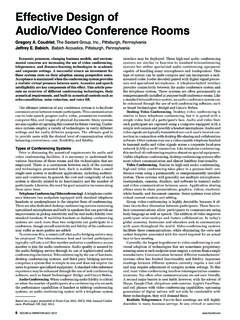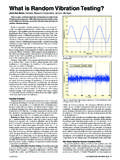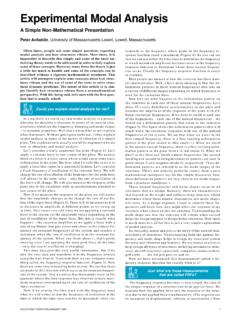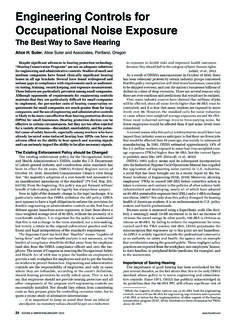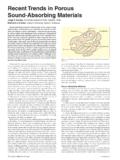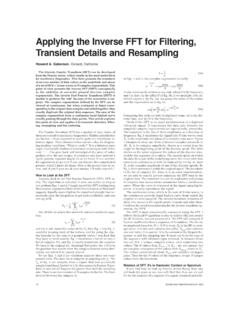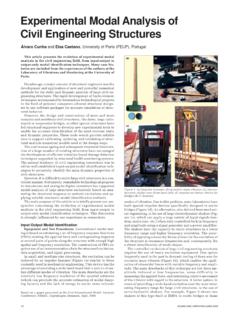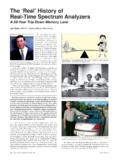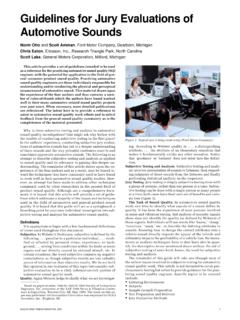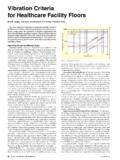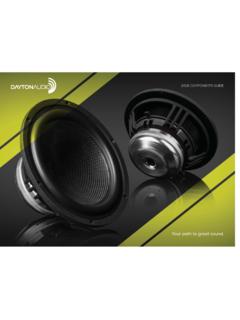Transcription of Interior Acoustic Simulation for In-Car Audio Design
1 SOUND & VIBRATION/JANUARY 2013 Interior Acoustic Simulation for In-Car Audio DesignToday s automotive Audio components have to meet high quality expectations with ever-decreasing development costs. Predictive methods for the performance of sound systems in view of the optimal locations of loudspeakers in a car can help to overcome this challenge. This article describes a number of sound-field Simulation tools to model the Acoustic and vibro- Acoustic aspects that come into play when transducers are mounted into small areas such as passenger compartment and door cavities.
2 Examples are shown how FEM software can predict the Acoustic modes of passenger compartments and door cavities. Automatic volume meshers are key to the success of the Acoustic FEM solutions. Vibro- Acoustic effects, such as speaker membrane vibrations coupled with door cavity Acoustic pressures and vibrations on the door trim can be taken into account using coupled structural and Acoustic FEM and BEM formulations. Also fast-multipole BEM is used to boost the realistic frequency range up to 5000 Hz and higher. For very-high-frequency modeling (above 5000 Hz), beam-tracing algorithms based on principles of ray acoustics can be deployed to synthesize binaural impulse responses and deriv-ing IACC-index maps.
3 Aspects of absorbent material properties (complex Acoustic impedance) and speaker characterization (velocities) are by customers who spend a lot of time in their cars, automakers challenge their infotainment departments and Audio suppliers with an ever-increasing demand on abundant Audio and multimedia applications inside vehicles, such as high-fidelity sur-round systems, Bluetooth phone communication, Audio -assisted navigation systems, or voice-operated control does one Design and optimize all passive and active com-ponents that influence in-vehicle Acoustic comfort?
4 And how to do this in compressed development time, preferable early in the vehicle development cycle, so not to compromise quality and cost?This article discusses some of the predictive methods that aim to reduce development time and increase in-vehicle Audio sound quality by means of sound-field Simulation and Vibro- Acoustic Parameters Sound Fields in Small Rooms. Automotive passenger com-partments can be considered very small rooms in terms of their acoustical properties. Depending on the frequency, the acoustics inside the car exhibit very different physical behaviors.
5 At low frequencies, wave acoustics dominate with a limited amount of widely separated Acoustic modes. At high frequencies, the sound field becomes more and more diffuse, making it more convenient to describe the sound field statistically. In this region peaks and dips do not correspond to eigen frequencies of Acoustic modes but are the result of numerous overlapping resonances. The term spectral coloration is used to characterize this phenomenon. Often the Schroeder cut-off frequency is suggested to mark the transition between low- and high-frequency regions.
6 This is about 300 Hz in a typical car Modes. The low-frequency performance of a vehicle Audio system is closely related to the cabin modes, which are considered useful to support the low-frequency auditory experience. For this reason it is of paramount importance that the woofer loudspeak-ers are placed so that they can couple with these modes. These locations are often in the front or rear corners of the Interior . See Figure 1 for the first longitudinal modes of a coupe. Obviously the eigen frequency values of these mode shapes depend very much on the type of the vehicle sedan, SUV, monospace, coupe, Doors.
7 Next to the Acoustic behavior of the vehicle cavity, the Audio system performance is also influenced heavily by the acoustics of the doors. Indeed, an important part of loudspeaker Design in Audio applications concerns cabinet Design . Influences of cabinet size, shape and flexibility will show up in the resulting radiated sound pressure field, which will deviate from the response of an idealized diaphragm in an infinite rigid baffle loudspeaker. For automotive applications, the cabinet consists of metal inner and outer door panels and the trim panel.
8 Figure 2 illustrates the door assembly. Some geometric parameters of the door are fixed trim and outer metal panel shapes as well as the total door volume are inherent to pure stylistic and ergonomic car Design , there are dangers attached to mounting loudspeakers in inner door panels. If contact areas exist between the vehicle cavity and the door cavity (such as door trim gaps and watershield holes), a coupling of the modes can results in door cavity modes absorbing some of the energy that was supposed to be transferred Soonkwon Paik, Hyundai Motor Co.
9 , Seoul, KoreaManu De Geest and Koen Vansant, LMS International, Leuven, BelgiumBased on a paper presented at Inter-Noise 2011, 40th International Congress and Expo on Noise Control Engineering, Osaka, Japan, September 1. First longitudinal and lateral modes of a Hyundai Genesis coupe at 64, 73, 108 and 115 2. Structural model for the front left door of a passenger SOUND & VIBRATION/JANUARY 2013 11to the vehicle problems of vibro- Acoustic nature can arise with the door trim. For fuel economy reasons, the door weight is often minimized by reducing the thickness of all panels and the area of the inner metal door sheet.
10 One can imagine this can have a possibly negative effect on loudspeaker performance. As the door panels become lighter, they will be more actively engaged in the vibro- Acoustic response triggered by the loudspeaker electrical input resulting pressure field in the cabin will come not only from the vibrating loudspeaker diaphragm but also from the sound-radiating trim panel. The influence of the latter can contaminate the tone color. More lightweight flexible panels will also cause more vibration of the loudspeaker unit, which has a certain mass and is mounted onto the Interior metal door panel.
